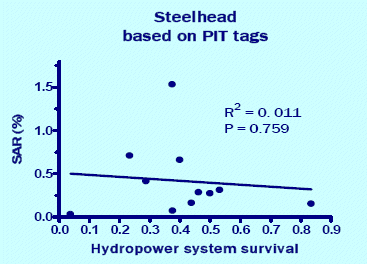News from the Front #90:
What If Columbia
and Snake River Dams Were Helping Salmon?
Of course no one believes
that pushing salmon smolts through a turbine is
helping them. But as billions of dollars
generated by the dams are invested in structural improvements, fish production,
habitat improvements, and control of natural predators, the possibility emerges
that all these efforts have generated a river system that, on balance, is more
survivable for fish than a natural river system.
Last week, Northwest Fishletter obtained an internal
memorandum from the National Marine Fisheries Service summarizing recent
studies addressing that question. The
memorandum presents estimates of smolt survival in
the Columbia and Snake Rivers as compared with the unregulated, unimpounded Fraser River in British Columbia, and the
regulated but unimpounded Sacramento River in
California.
·
Juvenile survival
through the
·
Juvenile survival
through the
·
Juvenile survival
through the
So on first appearances, survival down the
One can certainly quibble
with the details. The measurements for
the other rivers are taken further downstream.
Predator densities are highest below Bonneville Dam, so the Columbia and
Snake River numbers above need a downward adjustment—perhaps 10% more mortality,
perhaps more. The
A more exact analysis could easily show adverse effects
from the dams, as compared to a more natural, dam-free river, but those effects
would be small, and probably not enough to make much difference at all to adult
returns. Here is a recent graph of the
relationship between downstream steelhead survival and adult returns:

Juvenile survival through the
The NMFS memo is careful to say that the data from other
rivers are “preliminary” and “it is not appropriate to imply their meaning
regarding policy issues at this time”. But
one wonders when it will be time for Northwesterners
to wake up and realize that the massive and continuing campaign against the
dams is based on very significant misrepresentations. Powerful interests (investor-owned utilities)
have earned hundreds of millions of dollars annually from reducing power
production at the publicly-owned dams on the
Pretending
that the dams are killing most of the fish (rather than Mother Nature) saddles
us all with billions in increased electric rates, and funnels millions of tons
of additional carbon dioxide into the atmosphere annually. Even if fish
advocates don’t care about that, they ought to be wondering whether all this
focus on dams distracts sportsfishing interests from
what is really needed: sensible harvest
and hatchery management. Why on earth do
we take money from every taxpayer to release hatchery fish that aren’t
fin-clipped, so only the Tribes can keep them?
Why does a small Northwest minority with rights to “fish in common with
all citizens” get to take the vast majority of salmon and steelhead out of the
river? Why do sportsfishing
interests get thrown off the river with paltry allocations while gillnets continue
to decimate salmon and steelhead runs?
In large part, it is because sportsfishing
interests are distracted with constant fraudulent attacks on dams and
landowners that have no reasonable prospect of putting more fish in the river to catch.
© James Buchal,
November 7, 2007
![]()
You have permission to reprint this article, and are encouraged to do so. The sooner people figure out what's going on, the quicker we'll have more fish in the rivers.
Return to Other Salmon Materials
Return to www.buchal.com